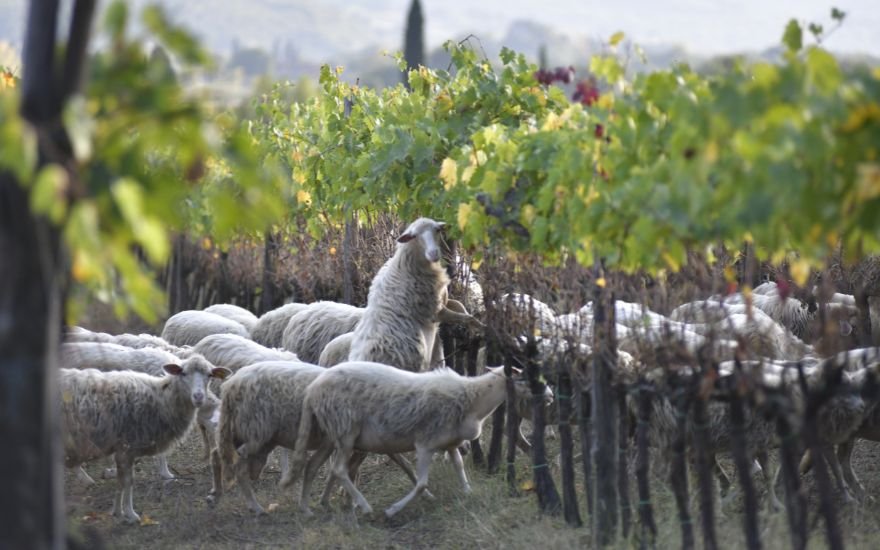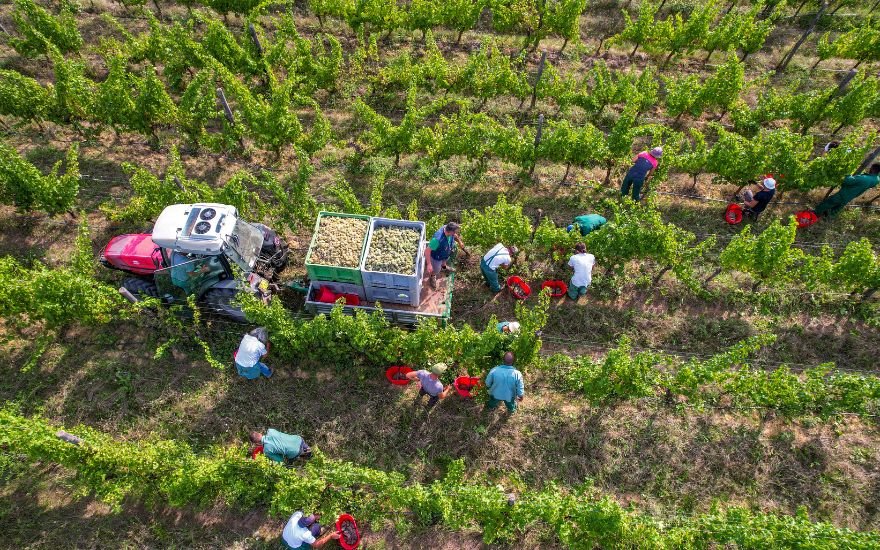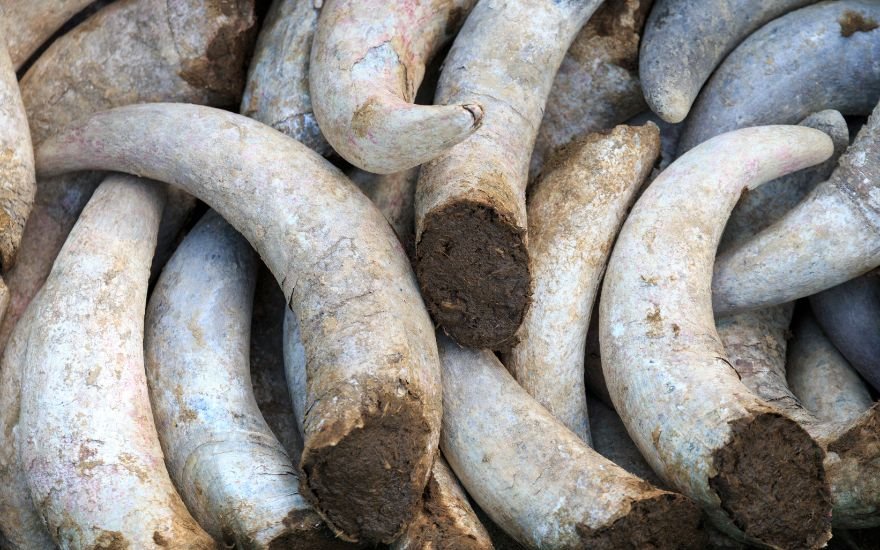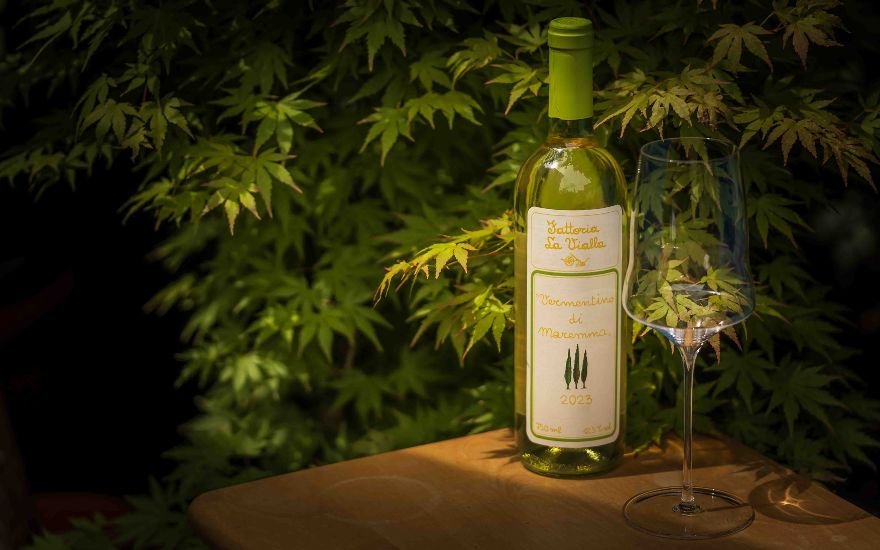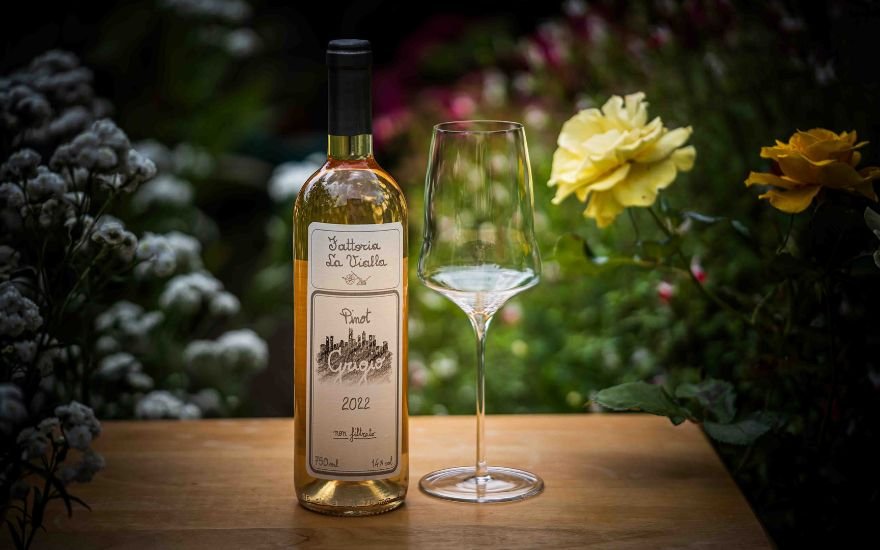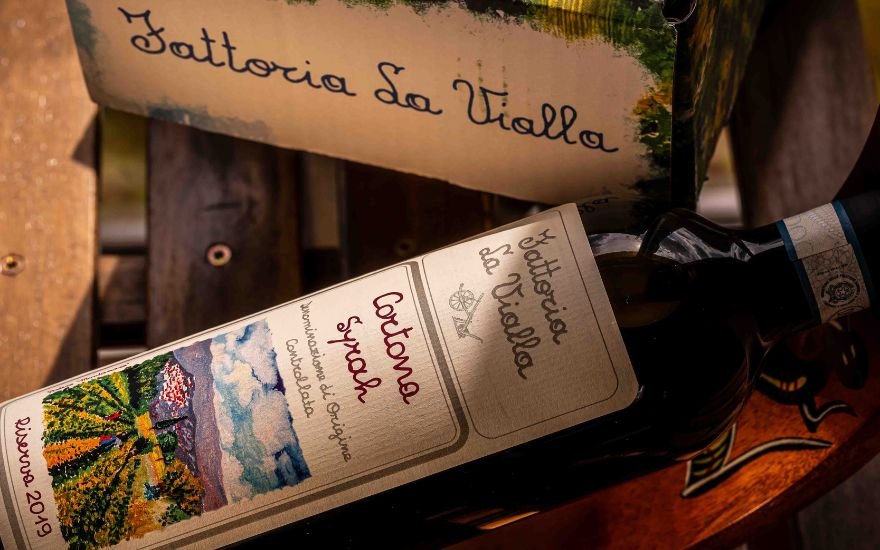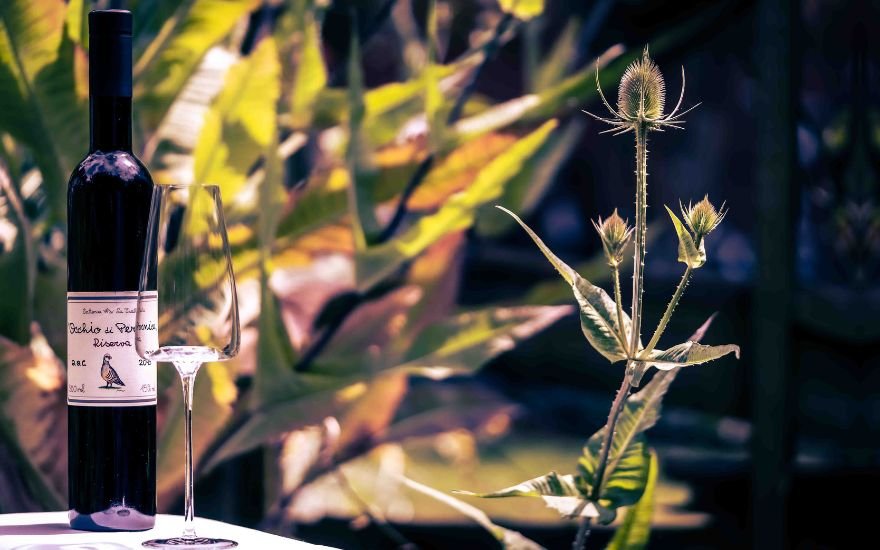Image credit: Fattoria La Vialla
The impacts of climate change now shape the long-term future of every vineyard and winemaker around the world. Savvy customers increasingly expect greater transparency on where and how the grapes are grown, and what goes into their favourite bottle of wine.
Modern commercial winemaking often depends on monoculture, rows and rows of vines lacking the biodiversity to cope with pests and disease outbreaks. To maximise crop yield, chemical fertilisers and synthetic pesticides are sprayed to protect the vines from pests, with industrial herbicides to maintain the land. The grapes are then harvested by hand or with mechanical equipment and processed using sulphites, enzymatic stabilisers, added sugars; the list goes on….
The industry standards and regulations around conventional wine making and labelling vary from country to country. We see ‘contains sulphites’ on the bottle but beyond that it’s often not possible to determine what farming practices have been used, or what and just how much of it has been added within the winemaking process. Above all, you are not able to tell what pesticides have been used on the vines/grapes and soil.
Fundamentally, soil health and biodiversity are everything - the quality and essence of the wine that takes you back to where the vines are tendered. You cannot make outstanding wines from mediocre grapes grown on over-farmed and depleted sites.
Next, we travel to Tuscany in Italy to find out more about how things can be done differently.
Fattoria La Vialla, Toscana
Image credit: Fattoria La Vialla
Outside Florence and Siena lie the rolling hills of Tuscany. For those in the know, venture further south towards Arezzo (the stunning location of Roberto Benigni’s Life is Beautiful). En route lies over 1,600 hectares of fields and forest owned and managed by Fattoria La Vialla, a family-run farm and wine estate.
This Fattoria (farm and wine estate in Italian) has been practising organic and biodynamic farming and winemaking since 1978. The estate produces its own wine, extra virgin olive oil, pecorino cheese, appetisers, sauces, pasta, vinegar, honey, biscuits and more - directly from vineyard to bottle, from vegetable patch to jar.
Their wines have received multiple awards in the past decade, including 159 alone in the first half of 2024! They have a multitude of mouthwatering farm produce and their farm diaries @fattorialavialla are well worth following. Their holistic and regenerative approach to agriculture and farming even extends to a growing range of biodynamic, Demeter-certified face and body care products made from upcycled olive water from their olive oil production, as well as dietary supplements. But this begs the question, what are biodynamic and organic products? Let’s find out more…
What are Organic Wines?
Image credit: Fattoria La Vialla
For over 45 years Fattoria La Vialla has cultivated its land using organic methods, but what do ‘organic viticulture’ and ‘organic wine’ mean?
Organic wine is wine produced with grapes from certified organic agriculture and only small amounts of a few additives and adjuvants are allowed, all of which must be of certified organic origin. A key point of organic production is the much lower quantity of sulphites used, compared to wines produced with conventional methods. The accepted limit of sulphur dioxide is 100 mg/l for dry red wines (versus 150 mg/l of conventional) and 150 mg/l for white and dry rosé (versus 200 mg/l of conventional).
The Italian word “biologico” for organic comes from the Greek “bios”, meaning life. Based on national and EU regulatory frameworks; to be awarded the logo “BIO”, a farm must undergo a three-year transition from conventional agriculture to a system that requires no chemicals used for pests, weeds and pathogenic organisms’ control. The use of GMO products is also prohibited.
To be labelled ‘organic wine’ with the Euro-leaf symbol, both the viticulture and winemaking processes must comply with very specific legal requirements, besides the general regulations for all wines. The label must also include the identification code of the certification agency. To maintain this status, farms are subject to annual inspections on traceability from vineyard to bottle.
Organic viticulture is not simply a business or ecological choice. Vines are self-pollinators that depend on wind. So, if your neighbouring farms or vineyards do not operate by organic standards, it would be a practical challenge to gain certification.
What are Biodynamic Wines?
Image credit: Fattoria La Vialla
Biodynamics is derived from the writings of the spiritual philosopher Rudolf Steiner in the 1920s, who saw the farm as an ecological whole: not just rows of grapevines but the soil beneath them—a living ecosystem—and the other surrounding flora and fauna, growing together to the rhythms of nature and the cosmos.
As suggested by the name, biodynamic wine is closely related to biodynamic agricultural practices, a discipline much closer to philosophy than science. The key differences between organic and biodynamic wine are based on a holistic view of cultivation. Biodynamics takes the concept of organic agriculture further, striving for synergy with nature and its cycles. Therefore, any wine produced with the biodynamic discipline comes from grapes cultivated following the lunar calendar, with pruning, irrigation and harvesting practices taking place on specific days. Harvest by hand is also a prerequisite.
Biodynamic wine is very similar to organic wine, but not subject to EU regulations. Its labelling also requires certification, the most common by Demeter. Besides prohibiting the use of all pesticides, herbicides and chemical fertilisers, certain biodynamic ingredients such as cow horn manure and cornosilica made according to specific prescriptions have to be applied by the lunar calendar. These requirements are more stringent than those for organic certification.
In addition, only glass bottles with non-plastic closures can be used and the level of permitted sulphites as compared with organic wines are reduced further to 90mg/l for whites, 70mg/l for reds, and only 60mg/l for sparkling wines.
At Fattoria La Vialla, all farming practices are biodynamic with over 832.66 hectares of land having obtained Demeter certification and the remainder of the land undergoing conversion. Besides their organic and biodynamic certification, all La Vialla wines are vegan and La Vialla has also adopted the “La Vialla’s Method”: a way of being and of doing things, which pervades the hearts of all the “Viallini”, both staff and family, with the shared mission of respecting people, animals and the Earth.
Now, let’s taste our way through some great organic and biodynamic wines from Fattoria La Vialla:
Sparkling Wine
"Mussantino Selvatico Rosé" 2023
Image credit: Will Wong
Made with 100% Pinot Nero, its deep fuchsia pink is bound to raise eyebrows in the bottle or glass. Despite it being a sparkling wine, you’d need a corkscrew! The gentle fizz comes with a bouquet of ripe strawberries. It’s a bone-dry easy drinking aperitif that is versatile with summer salads, smoked salmon and bresaola. Summer party crowd pleaser.
Size: 750ml
ABV: 12.5%
Find here: £11.75 each in a case of 6
Cuvée N2 Metodo Classico Millesimato 2016
Image credit: Will Wong
It’s pale appearance almost disguises the fact that this Traditional Method extra-Brut sparkling wine is a Blanc de Noirs made with 100% Pinot Nero. Multi award winning and best of show at Vinitaly, this Blanc de Noirs is aged for 64 months on its lees (secondary fermentation in the bottle like champagne). It has notes of elderflower on the nose and is crisp but soft on the palate. Allow a little time for it to open up and serve between 6-8°C. Pairs well with baked sea bass, steamed broccoli and Jersey Royal potatoes.
Size: 750ml
ABV: 12.5%
Find here: £24.95
Still White Wine
Vermentino di Maremma Toscana D.O.C. 2023
Image credit: Will Wong
Lesser known and often forgotten, Vermentino is more often associated with Sardinia or Corsica. A light-bodied wine that can be as deliciously complex as some Sauvignon Blanc. The grapes were harvested from Viallino vineyards in the Tuscan Maremma close to the sea, giving the wine crisp citrus acidity with a flinty and saline character. Perfect companion with pesto, white fish and seafood dishes. It works wonders with dim sum such as prawn dumplings, ‘shumai’ and spring rolls.
Size: 750ml
ABV: 12.5%
Find here: £8.65 each in a case of 6
Pinot Grigio I.G.T. 2022
Image credit: Will Wong
Blended with super ripe grapes from two sites, this unfiltered Pinot Grigio is bottled with the lees which you might find at the bottom of the bottle. This extends its bottle life if stored in darkness away from heat; and gives the wine extra texture over time. Chill the bottle upright in the fridge if possible.
Once the cork is drawn, you will be seduced by its lush tropical nose packed with peaches and nectarines ripened in the Tuscan sun. On the first sip, the wine is bone-dry with a slight tangy long finish, much like some funky ‘natural’ wines. Great companion with Caesar chicken kebab and aubergine. Best enjoyed with shellfish and crustaceans, either raw, steamed or grilled.
Size: 750ml
ABV: 14%
Find here: £9.60 each in a case of 6
Still Red Wines
Casal Duro I.G.T. 2020
Image credit: Will Wong
Aged for 24 months in barriques, the deep ink in your glass looks serious. Yet, its vibrant cherry nose and youthful soft tannins make this unfiltered Cabernet Sauvignon / Merlot blend very accessible now, with further cellaring potential of at least five years. Medium-bodied and robust, this multi-gold-award winning wine stands up to grilled red meat or roast beef with ease. Italian fares such as lasagne or tomato-based pasta and pizza are waiting.
Size: 750ml
ABV: 15%
Find here: £16.55 each in a case of 6
Cortona Syrah D.O.C. Riserva 2019
Image credit: Will Wong
As seen on the Impressionist painting on the label, the historic and scenic town of Cortona is perched on a hilltop where some of the best Syrah grapes are grown nearby. 2019 proved to be an exceptional vintage. Some of the harvest were aged in Slavonian oak with the rest in used 500-litre tonneaux barrels for 24 months. Once blended, the cuvée remains in the bottle for another year to soften the tannins.
In high summer with temperatures over 25ºC, it’s worth chilling the bottle before decanting at least an hour ahead of serving to let the wine breathe and open up. The result is an inviting cherry perfume nose followed by a dry black peppery long finish. Pair with any hearty red meat or winter stews. It even works with bitter dark chocolate!
Size: 750ml
ABV: 15%
Find here: £16.60 each in a box of two
Podere La Casotta I.G.T. 2018
Image credit: Will Wong
The beautifully illustrated front label gives us a glimpse of the picturesque landscape; with the once abandoned and derelict 18th century ‘podere’ (farmstead) facing a semi-circle of majestic cypress trees. Restoration began in 2002; together with planting varietals that are blended in this flagship red.
Three of the five grapes in the blend, including Sangiovese that makes Chianti famous worldwide, are left to dry out lying on racks in well-ventilated dry rooms until December. They are then combined with the other two already in fermentation. This process is called ‘appassimento’ and it creates a greater concentration of colours, aromas and flavours in the wine. The final blend is aged in barriques for 24 months, followed by 6 months in casks and a further 12 months in the bottle.
Decanted an hour ahead, the lovely herbal nose will take you up the hillside forest. It’s delicately smooth and balanced with soft tannins and dark fruits. Any underlying sweetness is restrained leading to a moreish fine red perfect to drink now and will age gracefully over 20 years if cellared with care.
Size: 750ml
ABV: 15%
Find here: £25.25 each in a box of two
Sweet Wines
Vin Santo 'Occhio di Pernice' Riserva D.O.C. 2015
Image credit: Will Wong
The ‘Liquid of Saints’ is hailed as the Prince of Tuscan dessert wines and won best of show at VinItaly with 96 points! Being a Riserva, the Sangiovese and Malvasia Toscano blend must be aged in small Caratelli (oak or cherry) barrels for at least 7 years. The concentrated sugar gives this honey nectar an ageing potential of 20 years. Enjoy at 15ºC on its own, with crème brûlée or strong cheeses.
Size: 500ml
ABV: 15%
Find here: £19.40
Respect for the Earth does not have to break the bank for us consumers. Fattoria La Vialla delivers your order without middlemen at very competitive prices. Giuliana and Piero Lo Franco began pursuing their dream of restoring the abandoned farm over 46 years ago and now their sons - Gianni, Antonio and Bandino – continue to run Fattoria La Vialla whilst being inspired by the idea of good, healthy food, and the protection of nature and its fruits.
Promoted from ‘carbon neutral’ to ‘climate positive; by the Nature Office of Italy in 2020, Fattoria La Vialla is a totally eco-sustainable, “climate positive” farm and wine estate. La Vialla hasn’t stopped here though, as in 2022 the United Nations Environment Programme (UNEP), together with the Food and Agriculture Organisation of the United Nations (FAO) chose Fattoria La Vialla as one of the #GenerationRestoration actors for the United Nations Decade on Ecosystem Restoration. The aim of the programme is to create a global movement to prevent, halt, and reverse the degradation of ecosystems, in which sustainable and regenerative agriculture plays a key role. We don’t know about you, but we can’t wait to see what Fattoria La Vialla does next!
Have you ever wondered what unfiltered wines taste like, or if it’s safe to drink the ‘bits’ floating in your wine, if so, click here. For those looking for some perfect pasta and wine pairings look no further than here.
By Will Wong

